Jack was a bit of a nightmare. Whirlwind might have been a better name for him. Whenever I went to catch a horse, he’d come blasting around at near light speed, right into the middle of the herd. Horses would scatter.
I was never certain if he was protecting the herd from me or if he was just a devil in disguise; determined to stir things up to make my day less than pleasurable. I’m aware that would be anthropomorphism but his apparent deviousness was certainly cause for skepticism.
So then, what was really going on? I certainly didn’t want to continue with the headache of trying to catch a horse with the energetic explosion that Jack brought with him. Well, the stars aligned one day and Jack’s owner let me know he was for sale and wanted me to do some work with him. I was happy to oblige, knowing that Jack needed some help. And I certainly wanted to rid myself of the catching issues.
Although horses generally get along and we seldom have problems putting them all together, occasionally one stands out that either causes trouble in the herd or for us. As herd leaders, it’s our job to fix that.
Let’s start with some theory. If you’ve read my other articles, you know that stressors horses experience can fall into one of the three following categories:
- Physical Stress – they’re tired, thirsty, hungry or sore in some spot. This is the easiest stress to attend to and we’re generally good at recognizing when a horse is off. Physical injuries can be obvious.
- Predator Stress – their anxiety is heightened because of an unknown threat (a movement in the trees or a scary thing in the arena corner) OR a known threat (they spot a mountain lion). Note that predator stress in some domestic horses is synonymous with training. We can change that, though, by becoming leaders and adopting a positive VS submissive training style.
- Herd Stress – the subject of this article. Read on!
A Lot of Value in a Little Bit of Knowledge
I have learned that the struggles folks have with horses are most effectively remedied with some knowledge about:
- how a horse thinks and perceives his environment,
- how a horse realizes and manifests anxiety and
- how to assist with his mental state in a positive and enduring way.
Without these essential understandings, we fall prey to:
- frustration and discouragement
- taking actions based on personification or the False Consensus Effect
- resorting to methods that we have read or have been taught. For example, having someone buck your horse out, punishing him when he misbehaves, forcing him to submit, working him until he’s exhausted or lunging him for 30 minutes before they ride so he doesn’t buck. These are also referred to as band-aid fixes, because they deal with the symptom instead of the cause.
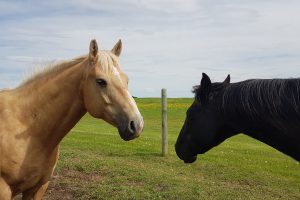 The problem is that there is a lot of “what to do” out there, but very little knowledge in the “why”. Honestly, knowledge and experience will always triumph over quick fixes and shiny marketing tactics. I’m certain that, at some level, we all know that.
The problem is that there is a lot of “what to do” out there, but very little knowledge in the “why”. Honestly, knowledge and experience will always triumph over quick fixes and shiny marketing tactics. I’m certain that, at some level, we all know that.
Most methods deal only with the horse’s physical state without a definitive connection to addressing his mental state. They deal with the horse’s actions as a result of unaddressed anxiety. As leaders, though, it’s our job to help the horse deal with the cause of the anxiety. This way he’ll have a positive mechanism to deal with anxiety whenever he experiences it: whether with us or in the herd.
Let’s use a human parallel to illustrate: We manage an office. For whatever reason, we continually task our employees with difficult jobs that are pushing their abilities – perhaps above their training or education level. Soon, we notice they begin to show signs of stress including irritability, angry outbursts and even resigning. If our solution to this is to give them harder work so they’re too exhausted to think about the task at hand, we’re thinking the same as many methods used to deal with horses. As responsible leaders, instead we look at ways of eliminating the causes of stress instead of dealing with the effects of it. In our office situation, we could consider sending our employees for educational upgrades and instituting workflow management programs.
Pause for Thought
Have you ever seen a horse with a red flag on his/her tail on a trail ride? You’re seeing a horse that hasn’t been shown a way to deal with herd stress yet.
When a horse pins it’s ears or moves to kick another horse, the answer isn’t to punish them for that. Contrary to popular belief, a horse cannot know right or wrong. Those are based on moral judgments, which horses are incapable of. We might be fooled into thinking we can teach them that, but they’re only learning that specific actions result in punishment from humans. They lack the ability to understand why. After all, they’re just doing what horses do.
The resolution comes when our horse understands that we’re the leader and it’s our job to take care of other horses in our herd space, not his. But that’s a whole other article!
It’s about Anxiety
Do a quick search on “anxiety disorder”. You’ll see symptoms including: always in a bad mood, terrified of being judged, panic attacks, constant worrying and inability to concentrate. Those symptoms are for people, but they apply to any sentient creature, including your horse.
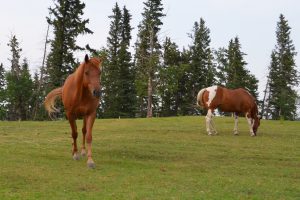 Horses are very social and are exceptionally relational animals. What that means is that their perceptions, understandings, actions and responses are based on interactions with others, and their herd. Herd stress is anxiety and is not unlike the stress people experience in social situations. How would you feel moving to a new city where you don’t know anyone? Starting a new job where you have little experience? Being a teen and switching schools halfway through the term? Feeling claustrophobic in large crowds? Having to work with someone you disliked? Have you ever had a room-mate that you couldn’t get along with?
Horses are very social and are exceptionally relational animals. What that means is that their perceptions, understandings, actions and responses are based on interactions with others, and their herd. Herd stress is anxiety and is not unlike the stress people experience in social situations. How would you feel moving to a new city where you don’t know anyone? Starting a new job where you have little experience? Being a teen and switching schools halfway through the term? Feeling claustrophobic in large crowds? Having to work with someone you disliked? Have you ever had a room-mate that you couldn’t get along with?
Except for the small percentage of their life that we’re working or riding them, horses spend the majority of their time in the company of other horses. That forms the biggest part of their life. Sometimes I don’t think we realize just how important their daily life affects their mental health; it can be easy to put our horse back in the pasture or barn after riding without considering what environment they’re going back to.
If you haven’t spent a full day with horses in a pasture as an observational or intergral part of the herd, I highly recommend it. You’ll learn an incredible amount about these animals.
Some Real Life Examples
Sometimes the problems are obvious. I had a horse in for training once that I put out with my herd. I get the feeling that, in a previous home, he was denied the opportunity to associate with other horses. The first thing he did – which he repeated more than once – was go trotting smack into the middle of the herd, as if to say, “Here I am! We’re all buddies, right? Right!?!?” This is about as socially acceptable as a person walking into a pub, barging into a group of strangers clearly engaged in their own stories, and taking over the conversation. Some would be amused, others offended. It just doesn’t work! It didn’t for this poor guy, either. My gelding, Spud, is the herd protector and he quickly put a run on this guy with a bite in the butt. Over time this boy found his place in the herd and developed some social skills.
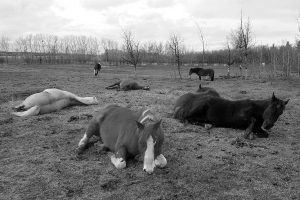 Other situations are not so obvious. I trained a horse once that was purchased by a young couple that didn’t know a heck of a lot about horses, but they were super people and really wanted the best for this mare. Well, they found a place to board her and she was put in a paddock with several other horses. Not long after that, I received a call. “This mare we bought can’t focus at all and we don’t even want to get on her!” They had trained with me a bit and I asked what they were doing with her in groundwork. They said that she couldn’t keep her attention off the paddock she’d been placed in. Right away I asked about how she was getting along with the horses in that paddock. They told me that she and another horse were not friendly. Things became clear at that point. The mare was experiencing some elevated herd stress as a result of a negative social situation. She couldn’t take her mind off of that; a situation exacerbated with the outdoor arena in plain sight of her stressful paddock. I suggested that they try her in a different paddock. The problems ceased.
Other situations are not so obvious. I trained a horse once that was purchased by a young couple that didn’t know a heck of a lot about horses, but they were super people and really wanted the best for this mare. Well, they found a place to board her and she was put in a paddock with several other horses. Not long after that, I received a call. “This mare we bought can’t focus at all and we don’t even want to get on her!” They had trained with me a bit and I asked what they were doing with her in groundwork. They said that she couldn’t keep her attention off the paddock she’d been placed in. Right away I asked about how she was getting along with the horses in that paddock. They told me that she and another horse were not friendly. Things became clear at that point. The mare was experiencing some elevated herd stress as a result of a negative social situation. She couldn’t take her mind off of that; a situation exacerbated with the outdoor arena in plain sight of her stressful paddock. I suggested that they try her in a different paddock. The problems ceased.
This isn’t to say that we always have to move a horse if they’re not getting along. As much as that might be a solution, it isn’t practical for most people, including myself. All my horses are together; their ability to get along is, in part, due to what I’ve taught them. There are functional, proactive solutions we can take to help them.
What to do?
We’ve touched on this in previous articles, but you’ll recall that when a horse experiences anxiety beyond what he can handle, he will respond instinctively by fleeing, freezing or fighting. These are normal actions for a prey animal to take.
Knowing this, our job is two-fold:
- To teach our horse an effective way of dealing with anxiety;
- To teach our horse to deal with a level of pressure above what he is experiencing in the herd.
We will then realize two significant benefits:
- The horse will realize that, with us as a leader, it’s our job to deal with anxiety, not his, and that in our presence he doesn’t have to worry;
- His confidence with handling a higher level of pressure will alter his herd behavior: those stresses that pushed him over the edge previously will no longer do so.
A Personal Story
My wild ex-stallion, Zeus, is a perfect example of positive change. When I first brought him home, he had NO desire to have anything to do with the other horses in the herd. He did not walk up to them to investigate. He was terrified and defensive. When he inadvertently wandered too close, he’d be chased out. The stress he was experiencing in the herd had much to do with his feeling alienated. The horses did not see him as another horse; his energy was too primal…too foreign.
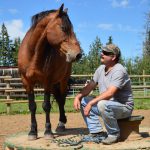
When he first arrived, I had to feed him separately. He lacked the courage to eat in line with the others. Recently I saw him eating between the herd’s top two. For Zeus to be between them shows not only that he’s accepted, but that he now possesses the confident energy required to be accepted. This change came with his confidence in engaging with the others.
That confidence was developed primarily through our work together. He now seeks me in the pasture and engages in play with me. He takes great delight in looking me in the eye; something he refused to do for a long time. I’m really tickled and enjoy my time with him.
What he learned from me: how to release tension when facing of unknown or threatening things. Including people and other horses. It’s changed his life. Literally.
To get started on the path to helping our horse manage stress issues, here’s an itemized list of what you’ll need:
- Yourself.
- A horse.
- A halter.
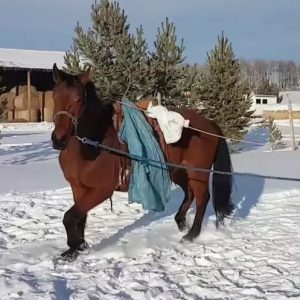
Pretty short list, isn’t it? Note our list doesn’t have supplements, chemicals or tools. This might be a bit uncomfortable for some because it means assuming responsibility instead of assigning it to a purchased product. We all know how hard that is, and I get it. We don’t want to fail.
However, the best part about our style is that there is no way to fail. We’ll focus on a proactive enduring solution based on an understanding of horses together with some relationship building with your own horse. When he or she learns that you have their best interest in mind, their try will increase and stress will decrease.
Here’s what you need to do. In your schedule, slot in some regular time to work with your horse. Once or twice a week is plenty. Sessions don’t have to be long. You’ll work initially on two things:
- Identifying what pressure level your horse can handle, and
- Teaching him something he’s never been taught: how to release tension and focus under pressure.
This is the quickest way to build his confidence. Most folks are surprised at how effective this is – but it make sense doesn’t it? We’re tackling the problem at it’s root.
Over time, which will vary depending on the horse, we work at introducing pressures in many different ways: rhythmic, random, different items to create pressure, pressure from different places, pressures on and off his body. The sky’s the limit here. There will be 4 constants throughout his/her training:
- You. The horse will follow your energy. If you apply pressure with anger or force, you’re teaching your horse to be angry or forceful under pressure (they’re born followers, remember?). You’ll learn to project calm to give your horse something to mimic.
- Your horse’s response. You’ll always be asking him to release tension and follow your focus.
- You’ll take care to work just underneath the limit of what your horse can handle while retaining focus.
- We’ll never leave our horse to figure it out on his own – it’s so much faster, enduring and trust based if we are the teachers.
Eventually what you’ll see is that your horse – on his own – will release tension when under pressure.
You’ll find I have many articles on leadership, focus and teaching horses to handle pressure. You can read them here. There are many videos on my website that will help as well.
We don’t throw first time skydivers out of airplanes – over and over and over – hoping they’ll figure it out, so we’re not going to do this with our horse.
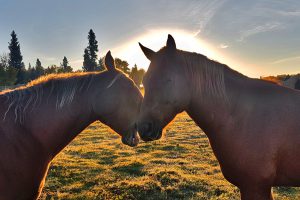 That said, it’s not wise to go out and start flapping tarps around a horse, or tying things to the saddle and sending him off – with the expectation he’ll figure it out on his own. It’s tempting to think that might be working, but it isn’t addressing the root issue. Our horse will only figure out that he’s not going to die from that specific item (at least some will) but he’ll have learned nothing.
That said, it’s not wise to go out and start flapping tarps around a horse, or tying things to the saddle and sending him off – with the expectation he’ll figure it out on his own. It’s tempting to think that might be working, but it isn’t addressing the root issue. Our horse will only figure out that he’s not going to die from that specific item (at least some will) but he’ll have learned nothing.
What he needs to learn is a connection between pressure/stress and releasing tension and focusing. In short, he needs to learn that pressure means releasing tension. He’ll only learn that with our assistance because it’s an association a horse is incapable of making on his own. He also needs to learn that our leadership is the key to removal of his stress – after all, we want to be confident on his back, right?
There is an art to asking a horse to release and focus. There is knowledge and feel behind what release is. It’s an easy art to learn and with some practice you’ll be an expert. These are things that I teach in every single clinic. They’re really hard to convey in words because they involve developing your energy, feel and empathy in the moment. Plan to attend one of my clinics – I love nothing more than sharing your excitement and progress as you develop a confident, athletic horse. One that will excel in whatever your discipline or riding interest may be.
To sum it up.
As leaders, we can teach our horses to deal with anxiety caused by other horses or their environment. What they learn is to release tension under pressure and focus or follow our direction and energy. Throughout this, they build confidence and an ability to deal with high levels of pressure. Thus, their herd problems decrease or disappear entirely, while at the same time their trust in you increases exponentially.
We’ve got an offer available now until February 15, 2019 – for any Progressive Horsemanship clinic you reserve a spot in, you’ll get a Progressive ONLINE session absolutely free. Check it out at amazinghorsecountry.com.
Scott Phillips
January 2019

